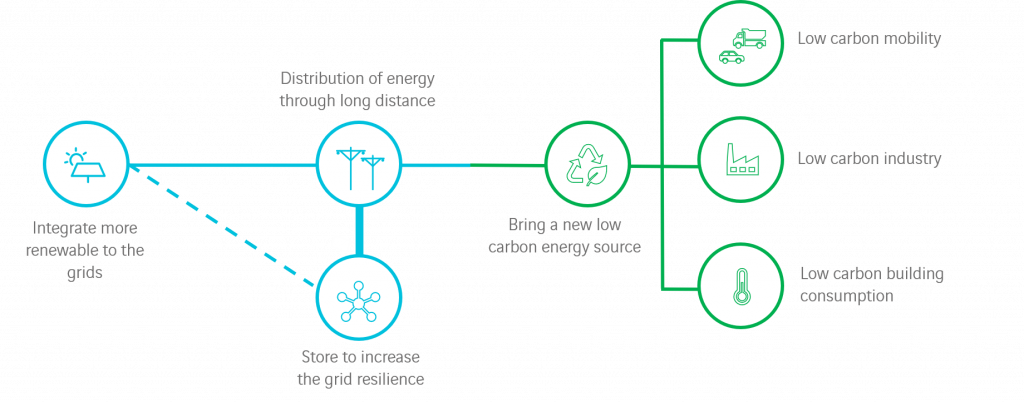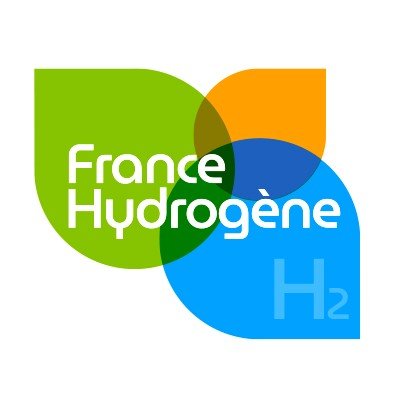What is Hydrogen?
Dihydrogen (H2), or commonly called hydrogen, is a very energetic gas molecule. This molecule is composed of two atoms of hydrogen, element among the most abundant on Earth. However, it is rare to find hydrogen in the atmosphere, as it is usually part of molecules such as water (H2O) or methane (CH4). Therefore, it needs to be synthetically produced.
Three types of hydrogen can be distinguished:
- Fossil-based hydrogen: also called “grey” hydrogen, very commonly used in industrial processes, mainly in the production of ammonia or in oil refining processes, today, hydrogen is mostly produced from fossil fuels (steam-reforming), a process that generates high carbon emissions ;
- Low carbon hydrogen: also called “blue” hydrogen, produced from steam-reforming processes, with resulted carbon emissions captured and stored (CCS), mostly underground.
- Renewable hydrogen: also called “green” hydrogen, produced via the electrolysis of water, when the electrolyser is powered by electricity generated from a renewable source. The electrolysis consists of splitting a water molecule (H2O) into a molecule of dihydrogen and dioxygen (O2) thanks to the input of electricity.
What are the uses of green hydrogen?
Green hydrogen can serve multiple uses, well beyond the scope of industry. The molecule is an energy carrier able to link multiple consumers to a unique source of energy (electricity), and therefore answer the sector coupling ambition, essential to decarbonise the economy.

Facilitate the integration of renewable energies by
- Overcoming the seasonal intermittence of these energies and increasing the resilience of the network, thanks to long-term storage,
- Distributing energy, thanks to the various means of transport and delivery of gas
Decarbonise the end uses in
- Mobility, an additional solution to electric vehicles, and mainly suitable for heavy transport, by road, rail, sea and air;
- Industry, to replace grey hydrogen produced by a polluting processes, as a feedstock or for the production of heat;
- The consumption of buildings through electricity and heating via the injection of green hydrogen or methane produced by the methanation processes into urban gas networks.
Therefore hydrogen contributes to the indirect electrification of various sectors of the economy. It plays a central role in the energy transition and as such is fully legitimate as one of the priorities that Omexom addresses through its various expertises.
Hydrogen territorial ecosystems
Hydrogen, added value in almost the entire energy sector
Hydrogen facilitates the development of local decarbonised energy policies in every activity sectors of a given territory:
Support territorial and local communities in their green transition
- Omexom has been selected by the region ‘Centre-Val de Loire’ in order to set-up a local green hydrogen ecosystem.
- The objectives are to: identify existing initiatives and stakeholders; gather and train entities interested in the subject; lead working groups to set-up up the local ecosystems.
- Omexom contributes to accelerate the development of territorial hubs by capitalising on local resources.

Migration towards a decarbonised and silent mobility
Power-to-Mobility
Hydrogen, an alternative fuel
- For road transport, mainly heavy transport, offering new perspectives:
- Its high energy density offers an autonomy of several hundreds kilometres when it is stored under pressure in vehicles (350 or 700 bars).
- It delivers a recharging time of just a few minutes, which is comparable to that of thermic vehicles.
Hydrogen vehicles represent a suitable solution for heavy (trucks and buses) and/or intensive uses (utility vehicles with a high usage rate), complementing full electrical solutions adapted to light vehicles and daily use.
- For fleet and mobility service operators, green hydrogen is an alternative to fossil fuel and complementary to electric and natural gas vehicles. Adaptation of fleets, and implementation of appropriate infrastructure require transverse skills: from technical, to financial, from installation to operation and maintenance
Today, Omexom already supports the development of electric-vehicle charging stations, for private fleets, as well as for public infrastructure deployements, for example in France and in Germany.
- For rail network operators, the hydrogen train provides an alternative to investment in the electrification or the renovation of regional lines.

“Service station of the future”
TIGA project, in Rouen (France)
Omexom has been selected to deliver the a lot called ‘the fueling station of the future’ in the TIGA* project “Rouen Normandie Mobilités Intelligentes pour tous”. The objective is to design, install and maintain a green hydrogen production and distribution station for the buses of the Rouen Metropolitan area.
This innovative project will contribute to the reduction of greenhouse gases compared with conventional buses, create jobs and offer energy independence to the territory.
*TIGA: Territoires d’Innovation de Grande Ambition
We promote the development of decarbonised energy networks and energies

Decarbonise the gas network
Power-to-Gas
Once produced, hydrogen can be carried over long distances through gas networks and blended with natural gas to decarbonise the use of gas:
- For gas system operators: injection of hydrogen (a limited proportion, to be increased along with upgrades of networks and end-user equipment) into the existing natural gas. This energy carrier contributes to decarbonizing gas uses whilst using existing infrastructures and thus minimising investment. In parallel, in Europe, new and dedicated hydrogenpipelines will be installed in the coming decade to connect producers and consumers.
Hydrogen can also be combined with carbon dioxide (CO2) through the methanation process in order to produce synthetic methane which can be technically injected into the gas network

Accelerate the development of renewable energies
Power-to-Gas-to-Power
Hydrogen can be stored in the long term, mainly in gaseous form, and re-converted back into electricity via fuel cell technologies. This is what we call Power-to-Gas-to-Power. This feature makes hydrogen attractive in a long term perspective for two main reasons:
- For solar or wind farm developers and operators: in design and operation, hydrogen’s ability to be stored over seasons enables wind and solar energy production to be more stable over the year. Hydrogen also allows the development of offshore wind projects which may be far away from existing networks, by providing an energy transport solution.
- For electricity system operators: hydrogen provides flexibility to meet the need for balance and optimization of the electricity network, especially encouraged by the decentralisation and re-dispatching of production (and storage) capacities within the grid.
.
-
 Omexom is a member of France Hydrogène & Mobilité Hydrogène
Omexom is a member of France Hydrogène & Mobilité HydrogèneBring together all the players in the hydrogen field: from energy companies to users.
Know more



